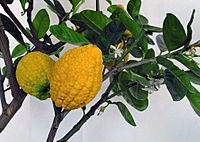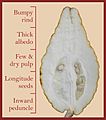Citron facts for kids
Quick facts for kids Citron |
|
|---|---|
 |
|
| Scientific classification | |
| Kingdom: | |
| Division: | |
| Class: | |
| Order: | |
| Family: | |
| Genus: | |
| Species: |
C. medica
|
| Binomial name | |
| Citrus medica |
|
The citron (Citrus medica) is a special type of citrus fruit. It's known for its very thick rind and small fruit sections inside. This interesting tree originally came from Southeast Asia. Today, you can find it growing in places like Sicily, Morocco, Crete, Corsica, and Puerto Rico.
The citron tree can grow to be about 3 meters (10 feet) tall. Its fruit can be quite large, sometimes reaching 25 centimeters (10 inches) in length and weighing up to 4 kilograms (9 pounds)! People usually don't eat the inner part of the fruit. Instead, the thick rind is the most important part. It's often used as an additive in cooking or made into Jam. The rind is also used to create vegetable oil for perfumes.
Citron is often eaten preserved or baked into treats like fruitcake. The candied peel is what's usually used in recipes. In some cultures, people even make a fruity tea from it. Long ago, a Roman writer named Pliny the Elder said that citrons only grew in Media and Persia. He mentioned that Romans tried to bring them to the Roman Empire but failed. However, we now know that citrons were grown in the Mediterranean area during Pliny's time. Experts believe the citron tree was first grown by people in India. They think it was one of the first citrus fruits, along with the mandarin and pomelo.
The citron has many different names around the world. For example, in French, it's called Cedrat. An ancient Greek writer, Theophrastus, called it the Persian or Median Apple. Later, it became known as the Citrus Apple. Other citrus fruits didn't arrive in the Mediterranean region until Islamic times. It's interesting that in many languages, a regular lemon is called a "citron," and a Lime is called a "limon." Also, the East Asian fruit called yuzu is sometimes confused with the citron, but it's actually a different species.
Contents
Growing and Using Citron
Citron trees grow slowly. They are usually started from cuttings that are two to four years old. The tree begins to produce fruit when it's about three years old. The fruit is long and oval-shaped, sometimes as big as six inches. Its skin is thick, a bit hard, smells wonderful, and has bumps on it. The inside pulp is white and a little bit sour.
How Citron Was Used Long Ago
In Pliny the Elder's time, people didn't eat the citron fruit. It only started being used in cooking around the early 2nd century. Instead, its strong, pleasant smell was very important. People would put citrons in their clothes to keep away annoying insects. It was like an ancient form of bug repellent!
Citron in Religious Traditions
In Hebrew, the citron is called the etrog (Hebrew: אֶתְרֹג). It is one of the Four Special Plants used during the Jewish holiday of Sukkot every autumn. The importance of the citron in this holiday was even shown in the Israeli movie Ushpizin. Citrons that have been mixed with lemon (to make more fruit or make the tree stronger) are not considered proper for use in the Sukkot traditions.
Citron in Different Cuisines
In South Indian cooking, especially Tamil food, citron is widely used in pickles and preserves. In Tamil, the unripe fruit is called 'narthangai'. This is usually salted and dried to make a preserve. The soft leaves of the plant are often mixed with chili powder and other spices to make a powder called 'narthellai podi'. This name means 'powder of citron leaves'. Both narthangai and narthellai podi are often eaten with 'thayir sadam' (Curd Rice, which is Yogurt Rice).
In Korea, citron is used to make a sweet, syrupy tea called Yuja cha. Thin slices of the whole fruit (peel, pith, and pulp) are soaked or cooked in honey or sugar to create a thick syrup. This candied fruit syrup is then mixed with hot water to make a fragrant tea. People also eat the fruit pieces at the bottom of the cup. Yuja tea is often preserved in syrup for the cold months, providing a source of fruit in winter. It's also popular in Taiwan, where it's known as 柚子茶 (Youzi cha).
Images for kids
-
An illustration of a fingered citron, showing its unique shape and the leaves and thorns common to citrons.
-
A citron or a citron-like hybrid from Italy, showing its very thick rind.
-
A fingered citron, known for its finger-like sections.
-
Citrons at a fruit market in Italy.
-
Citrons from Naxos with their leaves.
See also
 In Spanish: Cidro para niños
In Spanish: Cidro para niños


















